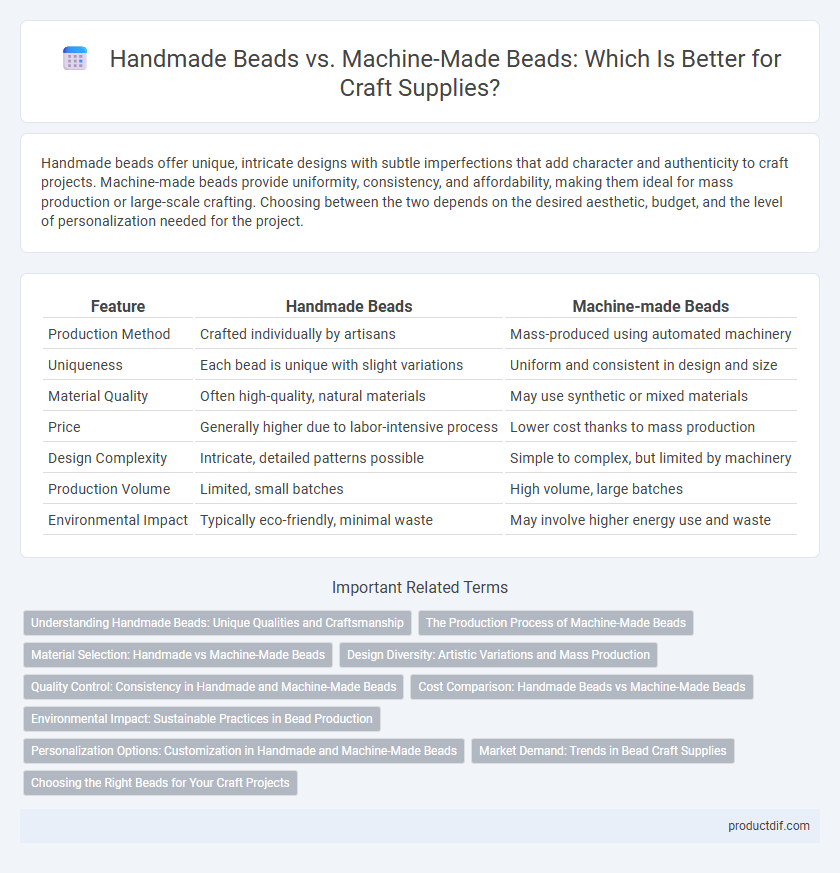Handmade beads offer unique, intricate designs with subtle imperfections that add character and authenticity to craft projects. Machine-made beads provide uniformity, consistency, and affordability, making them ideal for mass production or large-scale crafting. Choosing between the two depends on the desired aesthetic, budget, and the level of personalization needed for the project.
Table of Comparison
| Feature | Handmade Beads | Machine-made Beads |
|---|---|---|
| Production Method | Crafted individually by artisans | Mass-produced using automated machinery |
| Uniqueness | Each bead is unique with slight variations | Uniform and consistent in design and size |
| Material Quality | Often high-quality, natural materials | May use synthetic or mixed materials |
| Price | Generally higher due to labor-intensive process | Lower cost thanks to mass production |
| Design Complexity | Intricate, detailed patterns possible | Simple to complex, but limited by machinery |
| Production Volume | Limited, small batches | High volume, large batches |
| Environmental Impact | Typically eco-friendly, minimal waste | May involve higher energy use and waste |
Understanding Handmade Beads: Unique Qualities and Craftsmanship
Handmade beads exhibit unique qualities such as slight variations in shape, size, and color due to artisanal techniques that emphasize individual craftsmanship. Each bead is carefully crafted, often involving traditional methods like glassblowing or hand painting, which results in one-of-a-kind pieces with rich textures and intricate details. Unlike machine-made beads, handmade beads carry an authentic, personalized aesthetic that enhances the artistic value of craft projects.
The Production Process of Machine-Made Beads
Machine-made beads are produced through automated processes such as molding, cutting, and polishing with high precision and consistency. This mechanized production allows for large-scale manufacturing, ensuring uniform size, shape, and finish across batches. Advanced techniques like injection molding and computerized cutting optimize efficiency and reduce material waste compared to handcrafted methods.
Material Selection: Handmade vs Machine-Made Beads
Handmade beads often use natural materials like glass, clay, or semi-precious stones, offering unique textures and imperfections that enhance their artisanal appeal. Machine-made beads typically utilize synthetic materials such as plastic or resin, ensuring uniformity, durability, and cost-effectiveness for mass production. Material selection directly impacts the final product's aesthetic, quality, and value in both handmade and machine-made bead crafting.
Design Diversity: Artistic Variations and Mass Production
Handmade beads showcase unparalleled design diversity with intricate, unique patterns that reflect individual artistry, often incorporating cultural and traditional motifs not replicable by machines. Machine-made beads excel in mass production, offering consistent shapes and sizes, but typically lack the nuanced variations that characterize handmade craftsmanship. The choice between the two hinges on prioritizing artistic variation or uniformity for large-scale projects.
Quality Control: Consistency in Handmade and Machine-Made Beads
Handmade beads often exhibit unique variations due to the artisanal crafting process, offering individuality but less uniformity in size and shape compared to machine-made beads. Machine-made beads excel in quality control, providing consistent dimensions, color, and finish through automated precision, ideal for projects requiring exact matching. The choice between handmade and machine-made beads depends on the desired aesthetic; handmade beads emphasize uniqueness while machine-made beads prioritize consistency and replicability.
Cost Comparison: Handmade Beads vs Machine-Made Beads
Handmade beads typically command higher prices due to the labor-intensive craftsmanship and unique variations inherent in each piece, whereas machine-made beads benefit from mass production, resulting in significantly lower costs per unit. The cost difference also reflects material quality and production time, with handmade options often using premium or artisanal materials that contribute to their elevated price. For crafters prioritizing affordability and uniformity, machine-made beads offer an economical choice, while those valuing exclusivity and artisanal detail may prefer the investment in handmade beads.
Environmental Impact: Sustainable Practices in Bead Production
Handmade beads often have a lower environmental impact compared to machine-made beads due to their use of traditional, low-energy production methods and natural materials, reducing carbon emissions and waste. Machine-made beads typically rely on mass production processes that consume significant energy and generate more plastic and chemical waste, contributing to pollution and resource depletion. Choosing handmade beads supports sustainable practices by promoting eco-friendly craftsmanship and minimizing environmental footprints in bead production.
Personalization Options: Customization in Handmade and Machine-Made Beads
Handmade beads offer extensive personalization options, allowing artisans to create unique shapes, colors, and intricate designs tailored to individual preferences. Machine-made beads provide consistency and variety in mass production but have limited customization, typically restricted to pre-set patterns and standard color palettes. Customers seeking bespoke, one-of-a-kind craft projects often prefer handmade beads for their distinctive, customizable qualities.
Market Demand: Trends in Bead Craft Supplies
Handmade beads continue to attract crafters seeking unique, artisanal qualities and cultural authenticity, driving steady demand within niche markets. Machine-made beads dominate mass production with consistent quality, affordability, and wide availability, fueling their prevalence in mainstream bead craft supplies. Current market trends show growing consumer preference for eco-friendly and customizable handmade beads, impacting supply chain dynamics and pricing strategies.
Choosing the Right Beads for Your Craft Projects
Handmade beads offer unique variations in shape, color, and texture, making each piece distinct and ideal for personalized craft projects that value originality. Machine-made beads provide consistent size and uniformity, perfect for precision-driven designs or large-scale projects requiring quantity and consistency. Selecting between handmade and machine-made beads depends on whether the craft project prioritizes individuality or uniformity in bead appearance and production.
Handmade beads vs Machine-made beads Infographic

 productdif.com
productdif.com